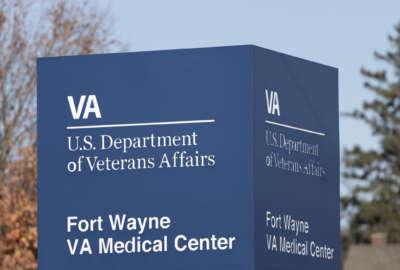VA hospitals score higher than private sector in nationwide surveys
The VA is on pace to provide more than 127 million medical appointments to veterans by the end of this fiscal year — a new record for the department.
The Department of Veterans Affairs’ hospitals are scoring higher than non-VA hospitals on two nationwide surveys that track patient satisfaction and care quality.
Nearly 80% of VA medical facilities received a four or five-star rating in the most recent Hospital Consumer Assessment of Healthcare Providers and Systems (HCAHPS) conducted by the Centers for Medicare & Medicaid Services.
By comparison, 40% of non-VA hospitals received those same star ratings. CMS based its latest HCAHPS scores on data collected between October 2022 and September 2023.
HCAHPS measures patient satisfaction after they’re discharged from the hospital, and tracks 10 criteria — including staff communication and responsiveness, hospital environment of care, willingness to recommend the hospital, and overall hospital rating.
This marks the ninth consecutive quarter in which VA facilities outperformed their non-VA counterparts on this scorecard.
Under Secretary for Health Shereef Elnahal told reporters these findings are supported by a systematic review the VA published last year, showing its health care is “consistently as good as or better than non-VA healthcare.”
The VA is on pace to provide more than 127 million appointments to veterans by the end of this fiscal year — when counting appointments at VA medical facilities and health care the VA pays for in non-VA medical facilities.
That many appointments would shatter the department’s record last year, when it provided 120 million total appointments to veterans.
“We’re offering more care to more veterans than ever before, and we are exceeding on all metrics — both patient experience metrics and overall hospital quality and patient safety metrics — when we are comparing apples to apples with civilian sector hospitals,” Elnahal said in a call last Friday.
More than 58% of VA hospitals also received four or five-star ratings in CMS’ Overall Hospital Quality Star Ratings, compared to 40% of non-VA hospitals.
The survey measures health care quality across five criteria — mortality, safety of care, readmission, patient experience, and timely and effective care. CMS based its scores on data collected between July 2019 and March 2023.
This is the second year that VA has participated in CMS overall hospital star ratings
“It was a many-year process to get our data calibrated and connected to CMS so that they can put it into their same algorithms that ultimately lead to the star ratings,” Elnahal said.
VA Secretary Denis McDonough said in a statement that millions more veterans are now eligible for VA health care under the PACT Act, “and now, we want to make sure that every one of them gets timely access to the world-class care they deserve.”
“Whenever a veteran sets foot in a VA facility, we want them to know that they are getting the very best care this nation has to offer – and we won’t ever settle for anything less,” McDonough said.
The PACT Act, signed into law in August 2022, expands eligibility for VA health care and benefits for veterans exposed to toxic substances during their military service.
About 740,000 veterans have enrolled in VA health care since the PACT Act was signed — that’s about a 33% increase over the previous two-year period before the PACT Act was signed into law in August 2022.
Elnahal said the VA still has some one-start and two-star facilities, and that some of these hospitals are “moving in the wrong direction” on these scorecards.
“We’re nowhere near perfect or where we need to be,” he said. “This is a continuous improvement effort, and tools like the overall CMS Hospital Quality Star Rating and the HCAHPS Star Rating are there so that we can continue to try and improve where we’re not performing at levels that we’re satisfied with.”
For the second year in a row, VA hospitals are now listed side by side with civilian sector hospitals on CMS’ Hospital Compare website.
Elnahal said veterans can use the site to see how VA hospitals in their area compare to other options they may have in the civilian sector.
“This allows them to make an informed choice on where they choose to receive their care,” he said.
About 92% of veterans say they trust the outpatient health care they receive from the VA.
“We have to earn veterans’ trust, and the best way we earn veterans’ trust is by offering them accessible, timely, and high-quality care,” Elahal said. “To the extent that our data overall instills more trust in veterans, I hope that’s the case, but the way that we really do that is by treating every single veteran with the care that they’ve earned and that the quality that they deserve, which is top notch.”
Elnahal said these hospital satisfaction scores generally track with employee satisfaction metrics, as tracked by the VA’s All Employee Survey.
Clinician burnout scores remain about the same as last year, and employee satisfaction scores remain on par or higher than last year’s scores.
“We don’t see satisfied veterans without an engaged workforce that feels like they have a supportive environment around them and are part of supportive teams. And so, in as much as we are principally focused on the veteran experience, we don’t get there without also being focused on the employee experience,” Elnahal said.
Elnahal said the VA is achieving these results because of its “incredible” workforce and its recent hiring efforts.
More than a third of VA’s health care workforce are veterans. Elnahal said many more VA employees have a close personal connection to veterans.
The VA hired more than 61,000 health care workers in fiscal 2023. The Veterans Health Administration has more than 400,000 total employees, its largest workforce so far.
“The combination of extremely successful hiring in fiscal year 2023 and also record retention moving into this fiscal year has placed our organization at the highest staffing level than we’ve ever seen,” Elnahal said.
The VA hired 14,000 nurses in FY 2024, and now has a record 122,000 nurses. The department is seeing a 3.4% turnover rate that Elnahl said is “far outperforming the private sector.
The department, however, is also feeling a budget crunch that’s impacting its ability to keep scaling up its workforce at the same rate.
The VA is asking Congress for an additional $12 billion to cover a projected budget shortfall for fiscal 2025, and is looking to cut 10,000 VHA positions through attrition.
“Overall, we’re in a bit of a title tighter fiscal picture this year,” Elnahal said.
Elnahal said this funding would support “at least a bit more” hiring, allow VA to provide more care within its health care network, and cover veterans’ care in non-VA facilities.
“Thankfully, even though we have been experiencing a bit of a title tighter fiscal picture this year, we did not see burnout symptoms go up, which is the most important metric that I think aligns with whether our employees think that we’re adequately staffed,” Elnahal said.
Copyright © 2024 Federal News Network. All rights reserved. This website is not intended for users located within the European Economic Area.
Jory Heckman is a reporter at Federal News Network covering U.S. Postal Service, IRS, big data and technology issues.
Follow @jheckmanWFED






